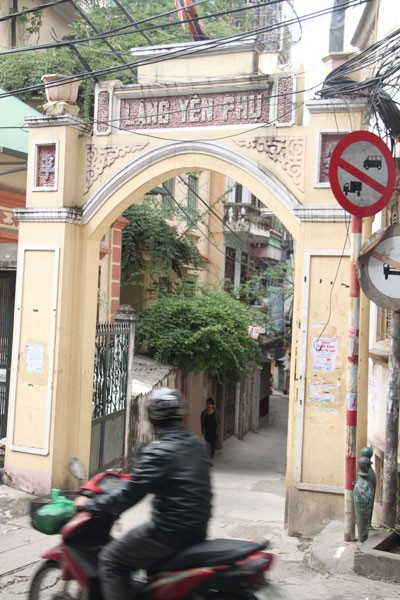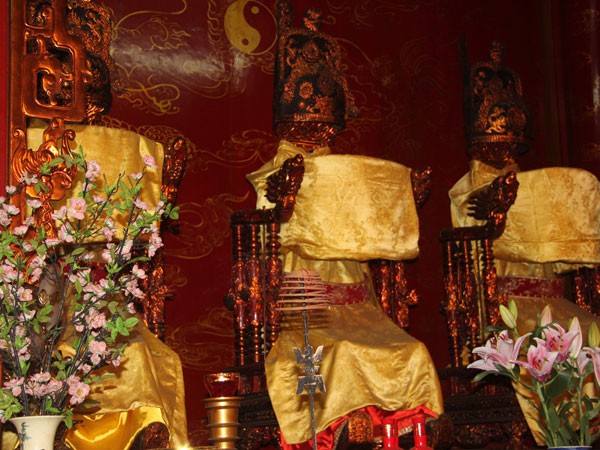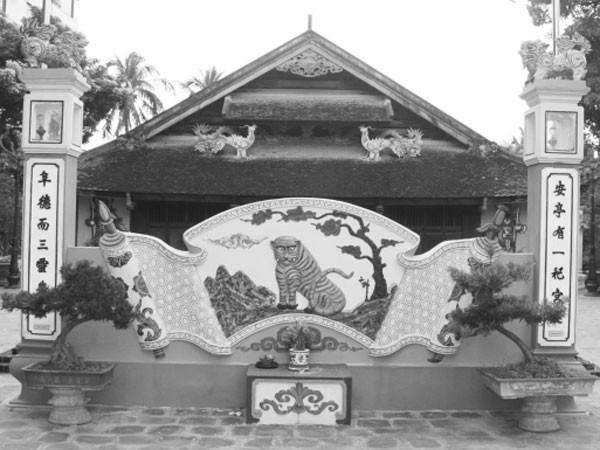ANTĐ – Unlike the horizontal arrangement of the altar of any communal house in Vietnam, the communal house in Yen Phu village (Tay Ho – Hanoi) has a strange feature that is the vertical arrangement of the altar similar to that of an anthill. The worshiping structure of Laos.
Tay Ho sacred land
The process of learning about Yen Phu communal house, from an ancient story that we found, Yen Phu communal house located in the present position is just “sub-land”. The main part of the land on which the communal house was built was on the banks of the Red River. After a flood caused a landslide, the seniors of Yen Phu discussed bringing the communal house inside.
However, it has been nearly 400 years since the communal house was completely moved to the land by the West Lake. The vestibule turns to the south, the cool breeze of the moon is around, the waves are bobbing, giving the communal house something more idyllic, more beautiful and also full of sacred air. If you just stand on the street or in the yard and look at the communal house, Yen Phu communal house is also small and lost among the rows of tall buildings near the edge of West Lake. But, when you step through the three steps and go inside, you can feel the magnificence and grandeur of the communal house.
Communal house 5 compartments 2 left with large columns divided into 7 compartments. The outer gable is a symbol of a two dragons adoring the moon with two phoenixes standing next to them. This is strange. It’s also strange because there is no family with a pair of dragons standing with a pair of phoenixes.
Mrs. Thu from Truong Thi Diep led us inside. The ironwood poles larger than the person hugging after nearly four centuries have rotted, but fortunately they were restored, so they continue to carry out the task of shouldering the roof of the village communal house. Mrs. Diep said, Yen Phu is an ancient village near the capital, located on the axis of Yen Hoa gate. So this village has a sub-name called Yen Hoa, north of the old citadel. Before, Yen Phu village was narrow and sparsely populated. On one side is a high dyke blocking the view, and on the other side is Dam Dam lake, ie West lake, where the famous case “turned into a tiger to kill the king” took place in which the wrongdoer was the talented Le Van Thinh.
Opposite the communal house gate is the long and winding fig pond. This pond is so named because there used to be a big mound where an old fig tree was planted all year round, full of honeydew fruit all year round. Now the tree is dead, the island has sunk. Only a handful of soil remained, with a small fig tree, probably planted a few years ago.
Three saints worshiped in Yen Phu’s harem
Worshiping the 3 great kings
During his lifetime, when GS. Tran Quoc Vuong is still alive, he has visited many times to find out and explain why Yen Phu communal house worships vertically. But because the answer was not available or he did not write it down, so far, those who know the story of worship can’t help but wonder when they come to this land. Yen Phu communal house is full of gilded splendor. All the altars inside are arranged in a vertical way in the middle, only the harem is horizontal. Why vertical worship? So the earth or a certain creed passed on?
To decipher a few things, you must enter the harem. But indeed, that sanctuary is only for dignitaries going out on the festival. So, with a lot of trouble, we were allowed to visit the harem for a few minutes. On the altar are three cloth-covered thrones worshiping the three saints. They were the Great King Uy Linh Lang, the Great King Vuong Doi and Vuong Ba Dai Vuong. As for Vuong Doi and Vuong Ba, no one knows their full names and relics. And Uy Linh Lang (not Linh Lang, son of the Ly king who worshiped at Voi Phuc temple – PV) is known as the prince of King Tran Thanh Tong and Queen Minh Duc.
One night, the queen dreamed that someone called Linh Lang (only the 5 sons of Lac Long Quan) asked to be reincarnated. After 14 months of heavy labor, she finally gave birth to a cyst. The king’s father thought it was the devil, so he sent his maidservant to the river.
The palace maid brought the prince to Nhat Chieu wharf, where there were 7 ancient rice roots left there, not thrown into the river as the edict. At night, that envelope gave off a dazzling halo of light over an area, illuminating the entire palace.
When the king found it strange that he had to go and find it, it was a very jovial boy. Growing up, that boy was intellectually intelligent, learning one to know ten. At the age of eighteen, he asked his father to leave home and head to the Buddha. When there was an invader in the country, the monk joined the army to fight there, so his father gave the title Uy Linh Lang. At the age of 36, he was not sick or sick, but he transformed himself, only asking to be worshiped in Yen Phu land, where the river wharf was.
Yen Phu communal house, a unique place of vertical worship in our country
Still a mystery
Back to the story of why Yen Phu communal house worships vertically, there are no books to explain. The writer of this article found that in Laos, most of the temples are arranged vertically like Yen Phu. Or in the Central region of our country, in a talk with researcher Dang Ngoc Lien, he said that before 1964, when the US had not bombarded, many villages had temples and shrines to worship on the left door. That is also a type of vertical worship, and why is that, he does not know. In Laos, the way of vertical worship is a tradition. Returning to Yen Phu communal house, Mrs. Thu from Truong Thi Diep only dared to conjecture that: Before, when the communal house was still in the yard because of its narrow area, the elders arranged the worship vertically.
Currently, Yen Phu communal house still retains many epitaphs of the Le dynasty. Among them are 3 large steles erected in the yard. Two 2-sided stele, 1 4-sided stele recording history, merits and people with meritorious services to the communal house. Inside the harem, there is a stone stele that is “the king’s base”. Because in the past, there was a person who wanted to occupy the communal house, the judge let the communal house win and had a black and white paper made of it. But after the flood, the paper drifted away. He wants to take over the land. This time, the people complained to the king. The king ruled for the family to win. And to be sure, the king had words engraved on the stone stele so that forever no one would peek at the land of the communal house. That stele, known as “the stele of the king’s ban” and is still quite intact in both the handwriting and the pattern on the forehead of the stele.
Source: Collected internet.


